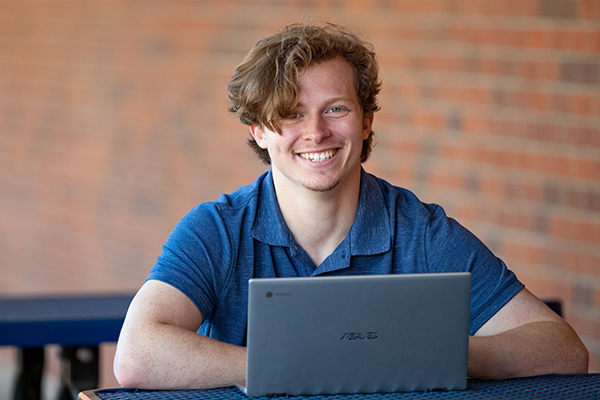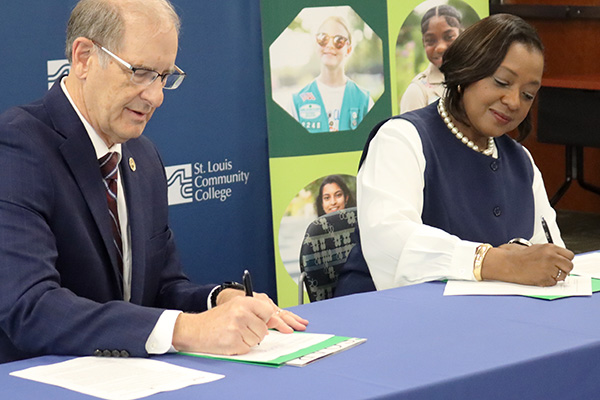Financial Aid 101: Your Guide to Common Questions
October 14, 2025
Posted by STLCC in Paying for College

St. Louis Community College offers affordable tuition, supportive enrollment staff and a variety of financial aid options. This guide answers common questions and helps you take confident steps toward college success. First-time, returning and transfer students will all find useful tips here.
You'll learn:
- What financial aid is and how it works
- How to apply for help, step-by-step
- The different types of financial aid available
- How to avoid common mistakes
- Where to go when you need help
Keep reading to find out how to make college more affordable... and a lot less stressful!
Understanding Financial Aid
Financial aid can feel complicated, but a few basics can give you the tools to manage your college costs.
What Exactly is Financial Aid?
Financial aid is money that helps you pay for college. It can cover:
- Tuition and fees
- Books and supplies
- Technology like laptops or calculators
- Transportation
- Even some living expenses such as housing or meals
STLCC students can receive aid from several sources, including:
- The federal government
- The state of Missouri
- St. Louis Community College and the STLCC Foundation
- Outside organizations like clubs, churches or employers
Most programs use the FAFSA (Free Application for Federal Student Aid) to determine how much financial assistance you can receive.
Types of Financial Aid
Financial aid comes in four main forms: scholarships, grants, loans and work-study.
Grants are a type of financial aid you don’t have to repay, as long as you meet the eligibility requirements. They’re usually based on financial need, which is determined by your family’s income.
- Need-based aid that helps make college more affordable
- No repayment required if you stay eligible
- Can cover tuition, books and supplies
- Examples include the Federal Pell Grant and Missouri state grants
Scholarships aren’t just for straight-A students. They’re awarded for a variety of reasons, including your achievements and interests.
- Can be based on academics, talents, community service, leadership, financial need or career goals
- Offered by STLCC and outside organizations
- You don’t need perfect grades to qualify
Loans help pay for costs that grants and scholarships don’t cover. They must be repaid—with interest—after you leave school or drop below half-time.
- Let you borrow money for education expenses
- Federal student loans usually have fixed interest rates
- Repayment typically starts six months after you leave school or drop below half-time
- Tip: Only borrow what you really need to reduce future debt.
Work-study jobs let you earn money while you attend school, often in positions connected to your area of study.
- Provides part-time, on- or off-campus jobs
- Helps cover educational expenses
- Offers valuable work experience and resume building
- Funds are limited—apply early if interested
How to Apply for Financial Aid
Filling out the FAFSA is the most important step in getting financial aid. It determines what federal and state aid you qualify for, and many scholarships use it as a reference.
Here’s what STLCC students need to do:
- Create an FSA ID at studentaid.gov. You’ll need this ID to log in and sign the FAFSA. If you’re under 24, a parent will need an ID too.
- Gather your documents. You'll need:
- Social Security numbers (student and parent)
- Federal tax returns and W-2s
- Any untaxed income information
- Parent information, if you're a dependent student
- Add STLCC’s school code: 002469. This is how STLCC receives your info.
- Complete the FAFSA online at studentaid.gov.
- Choose the correct school year and fill out all the questions carefully.
- Use the IRS Data Retrieval Tool to pull in tax data automatically.
- Sign and submit. Use your FSA ID (and your parent’s too, if needed) to sign the FAFSA.
- Once submitted, you’ll see a FAFSA Submission Summary. Be sure to check it for mistakes.
- Fix any mistakes right away. Log back in, correct anything that’s wrong and resubmit.
- Respond to verification requests. Sometimes STLCC or the federal government may ask for extra documents to verify your information, so be sure to check your email and respond quickly to avoid delays.
- Review and accept your aid. Once processed, you’ll see your financial aid offer in your Archer Connect account. You can accept all, part or none of it. Choose what’s best for you.
Exploring Scholarship Opportunities
Scholarships are a great way to reduce college costs—and you don’t have to pay them back.
Start by exploring STLCC scholarships, many of which are funded through the STLCC Foundation to support students like you. These scholarships are available for a wide range of majors, interests, and backgrounds.
Don’t stop there! You can also find scholarships from local community groups, churches, employers and professional organizations in your area of study. Many are based on community involvement, career goals or personal stories—not just grades.
There are more opportunities than you might think, so apply for as many as possible each year. Even smaller awards can add up and make a big difference.
Tips for Applying to Scholarships
A great scholarship application helps you stand out. Use these tips to make yours shine.
- Write a strong personal essay.
- Take the time to clearly explain who you are, your goals and why you’re applying for the scholarship.
- Use real examples from your experiences, like challenges you’ve overcome or achievements you’re proud of.
- Make sure it’s well-organized, easy to read and free of spelling or grammar errors.
- Ask for recommendation letters early.
- Give your teachers, mentors or supervisors plenty of time to write thoughtful letters.
- Share information about the scholarship, your achievements and your goals so they can write a personalized and supportive letter.
- Show your community and extracurricular involvement.
- Highlight volunteer work, clubs, sports, leadership roles or other activities that show your skills, dedication and commitment.
- Even small contributions can make a difference if you explain what you learned or how you made an impact.
- Keep your grades up.
- Many scholarships consider academic performance, so maintaining good grades can open more opportunities and strengthen your applications.
Smart Ways to Maximize Your Financial Aid
A little planning can go a long way in helping you get the most out of your financial aid.
- Apply early: The sooner you apply, the more options you’ll have for grants, scholarships and work-study opportunities.
- Stay organized: Keep your tax forms, W-2s and other important documents in one place so you’re ready when it’s time to apply or verify your information.
- Check your STLCC email and Archer Connect often: This is where you’ll receive important updates, requests and next steps about your financial aid.
- Apply for scholarships every year: Many scholarships renew annually, and even smaller awards can make a big difference over time.
- Borrow only what you need: Taking out less in loans now means less to repay later, helping reduce financial stress after graduation.
- Ask for help: The enrollment services team is available to guide you through every step of the process. Don’t hesitate to reach out with questions.
Common Financial Aid Questions and Myths
It’s easy to get mixed messages about financial aid—here’s what you really need to know.
Busting Financial Aid Myths
You may have heard some of these things about financial aid. Let’s set the record straight.
“My grades aren’t good enough to get aid.”
Not true! Many grants and loans don’t require high grades.
“My family makes too much money to qualify.”
You won’t know until you apply. The FAFSA looks at more than just income.
“Only full-time students qualify.”
Part-time students can often still get aid—just sometimes in smaller amounts.
“I don’t want loans because I have to start paying right away.”
Most federal loans don’t need to be repaid until six months after you leave school
or drop below half-time.
“Books and supplies aren’t covered.”
Financial aid can help with books, laptops and even transportation, depending on your
package.
Frequently Asked Financial Aid Questions
We’ve gathered answers to the questions students ask most about financial aid.
Do I need to complete the FAFSA every year?
Yes. Financial aid is not automatically renewed. Each year, your financial situation,
enrollment status and available aid programs can change. Filing a new FAFSA ensures
you get the maximum aid for the upcoming academic year.
Can I get aid if I’m only taking a few classes?
Yes. Part-time students can still qualify for financial aid, although the total amount
may be smaller than for full-time students. Aid is usually prorated based on the number
of credit hours you take.
What is Satisfactory Academic Progress (SAP)?
SAP is a set of standards you must meet to keep receiving financial aid. It generally
requires that you:
- Maintain a minimum GPA
- Complete most of the classes you attempt
- Finish your program within a reasonable timeframe
If you fall behind, you could lose your aid, but there are often appeal options and support services to help you get back on track.
Can I change my loan amount later?
Yes. You don’t have to accept the full loan amount offered. You can start with a smaller
amount and request more later if your financial situation changes or additional costs
arise.
What if my family’s income changes after I file the FAFSA?
Notify your financial aid office. They can review your case through a professional
judgment process, which may allow you to qualify for more aid if your circumstances
have changed significantly.
How do I get a work-study job?
Work-study is a federal program that provides part-time jobs for students with financial
need. If you qualify, it will be listed in your financial aid award. To secure a job,
apply early and respond quickly to postings, as positions are limited.
Your Next Steps at STLCC
Now that you know your options, here’s how to keep your momentum going.
- Take action early: Submit your FAFSA and scholarship applications as soon as possible. Early action means more options and less stress later.
- Stay connected: Check your STLCC email and Archer Connect regularly for updates, next steps and deadlines.
- Keep moving forward: Once your aid offer arrives, review it carefully and follow up with any required forms. Don’t hesitate to ask for help. Our staff can walk you through every step.
- Stay eligible and supported: Keep your grades up, manage your classes, and use the many STLCC support services—like advising, tutoring, the Access Office and veteran resources—when you need them.
- Reach out anytime: If you have questions, contact enrollment services or call the Financial Services Hotline at 866-452-7579.
Remember: You’re not in this alone! STLCC is here to help you succeed, every step of the way.





